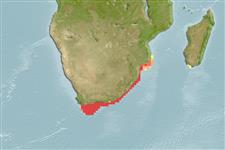Elasmobranchii (Haie und Rochen) (sharks and rays) >
Pristiophoriformes (Saw sharks) >
Pristiophoridae (Saw sharks)
Etymology: Pliotrema: pleion (Gr.), more; trema (Gr.), hole, referring to six gill slits compared with five in Pristiophorus. (See ETYFish); warreni: In honor of English-born South African zoologist Ernest Warren (1871-1945), Director, Natal Government Museum (Pietermaritzburg), who sent specimens to the British Museum. (See ETYFish).
More on author: Regan.
Environment: milieu / climate zone / depth range / distribution range
Ökologie
seewasser demersal; tiefenbereich 10 - 915 m (Ref. 122027), usually 60 - 430 m (Ref. 122027). Subtropical; 22°S - 37°S, 19°E - 45°E (Ref. 54706)
Western Indian Ocean: off Madagascar and from southern Mozambique to Cape Agulhas, South Africa.
Length at first maturity / Size / Gewicht / Alter
Maturity: Lm ?, range 110 - ? cm
Max length : 170 cm TL Männchen/unbestimmt; (Ref. 5578)
This large six-gilled sawshark is distinguished by the following characters: barbel origin to anterior nostrils 1.4-1.6 times anterior nostrils to symphysis upper jaw; prenarial length 1.3-1.4 times prebarbel length; preoral length 1.8-2.3 times interdorsal space; pectoral-fin anterior margin 1.4-1.5 times dorsal-caudal space; mouth width 3.1-3.9 times spiracle length; the first dorsal fin originates about opposite pectoral-fin free rear tips; lateral trunk dermal denticles tricuspidate, rather flat and imbricated. monospondylous centra 53-56; precaudal diplospondylous centra 4-51; total vertebral centra 154-158; rostrum not constricted between barbel origin and nostrils and barbels that are situated about two thirds way from rostral tip to mouth, with prebarbel length about twice, i.e. 1.7-2.1 times, distance from barbel origin to symphysis of upper jaw (vs. barbels situated about half way from rostral tip to mouth, with prebarbel length about equal, i.e. 1.0-1.1 times, distance from barbel origin to symphysis of upper jaw), prebarbel length 60.2-68.0% (vs. 49.4-52.9% of preoral length), preoral length 1.5-1.7 (vs. 1.9-2.0 times prebarbel length), prenarial length 1.3-1.4 (vs. 1.5-1.7 times prebarbel length). Colouration: medium to dark brown dorsally with a pronounced yellowish longitudinal stripe; uniform white ventrally; the dorsal rostrum surface with two distinct longitudinal dark stripes, lateral rostral teeth dark-edged (Ref. 122027).
Found on the continental shelf and upper slope to at least 430 m (Ref. 247). Feeds on bony fish, also shrimp, mysids and squid (Ref. 5578). Ovoviviparous (Ref. 50449), with 5 to 7 young in a litter (Ref. 247). Probably uses its saw to stun and kill prey (Ref. 5578). Sometimes caught by sports anglers (Ref. 5578).
Ovoviviparous, with 5 to 7 young in a litter (others have 7 to 17 developing eggs). Size at birth about 35 cm. Embryos feed solely on yolk (Ref. 50449).
Weigmann, S., O. Gon, R.H. Leeney, E. Barrowclift, P. Berggren, N. Jiddawi and A.J. Temple, 2020. Revision of the sixgill sawsharks, genus Pliotrema (Chondrichthyes, Pristiophoriformes), with descriptions of two new species and a redescription of P. warreni Regan. PLoS ONE, 15 (3)[0228791]:1-56. (Ref. 122027)
IUCN Rote Liste Status (Ref. 130435)
Bedrohung für Menschen
Harmless
Nutzung durch Menschen
Fischereien: nicht kommerziell; Sportfisch: ja
Mehr Information
ReferenzenAquakulturAquakultur ProfilZuchtlinienGenetikElectrophoresesVererbbarkeitKrankheitenVerarbeitungNutrientsMass conversion
PartnerBilderStamps, Coins Misc.LauteCiguateraGeschwindigkeitSchwimmstilKiemenoberflächeOtolithsGehirngrößeSehfähigkeit
Tools
Zusatzinformationen
Download XML
Internet Quellen
Estimates based on models
Preferred temperature (Ref.
123201): 11.2 - 21.7, mean 15.8 °C (based on 40 cells).
Phylogenetic diversity index (Ref.
82804): PD
50 = 1.0078 [Uniqueness, from 0.5 = low to 2.0 = high].
Bayesian length-weight: a=0.00389 (0.00180 - 0.00842), b=3.12 (2.94 - 3.30), in cm total length, based on all LWR estimates for this body shape (Ref.
93245).
Trophic level (Ref.
69278): 4.2 ±0.6 se; based on diet studies.
Widerstandsfähigkeit (Ref.
120179): sehr niedrig, Verdopplung der Population dauert mehr als 14 Jahre. (Fec=5).
Fishing Vulnerability (Ref.
59153): Very high vulnerability (90 of 100).
